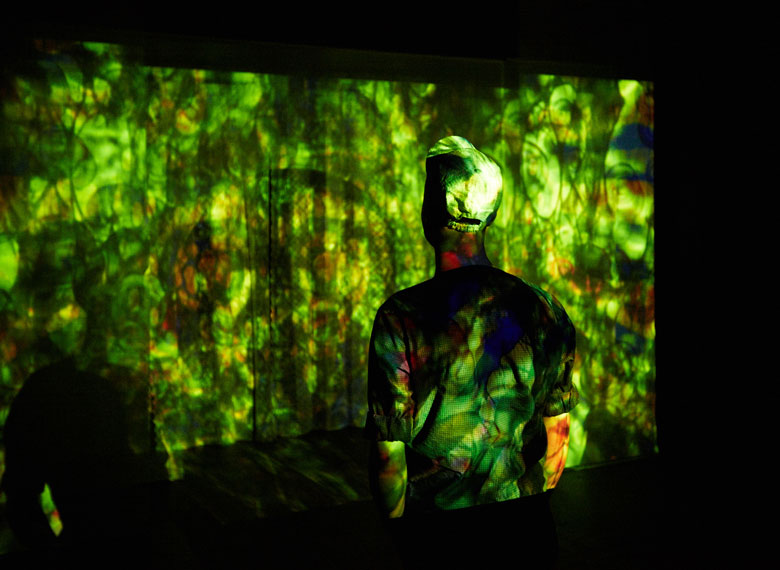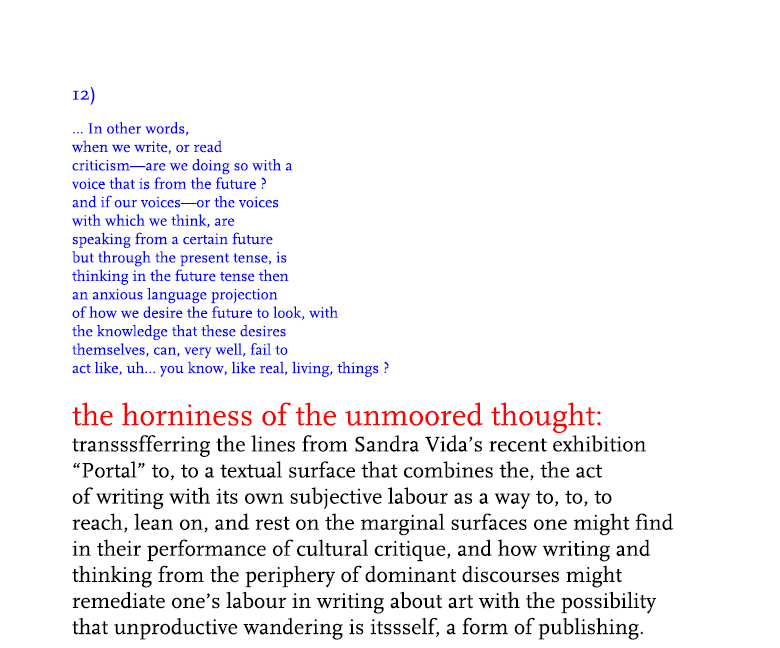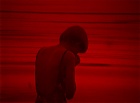what is the point to analyze
life when life itself seems to be
such a careless and unpredictable
performance?June 13, 2016
↩
Cradled by my phone’s heartbeat, I spent hours on the couch, staring
at the different ways in which the world (or rather my uneven
experiences of it) reflects its textures inside the murky surface of this
wi-fi network that now, like a mental IV pump, infuses my
thoughts with bizarrely random and sometimes paranoid
streams of news coverage, Facebook posts and outbursts of personal
gestures that comment on, as they rearrange details from the recent
Orlando nightclub shooting in Florida. Next to this endless
precipitation of images, one thing is clear—that the more I think about
these events, the more unable to write I feel: I don’t know anymore if
what I am unable to write is a text that performs itself critically, and
vigorously critical of its criticality, or if something deeper from inside
me had snapped in such a way that criticality—or the labour that one is
prepared to invest in their attempt to, to, to change what they want to
see changed in the world; if the idea of an activist textual action, at this
present moment, has renrendered itself to be counterproductive to
reaching any sort of sensible resolution. (with this I wonder if it is
possible to change the world through one’s absence from it, and if so,
how can this inaction, act in the world ? aaand.. can passivity be
performed as a form of political action ? )- ↩
- ↩
- ↩
- ↩
- ↩
- ↩
Although I was five years old at the time, one of my earliest childhood memories is marked by
the crackling sound of bullets as they dug their way through the walls of the nearby apartment
buildings where I grew up, in Bucharest, during the 1989 Revolution. Today, having lived in
Canada for a large chunk of my adult life, looking back on these events with a somewhat detached
perspective, I see the 1989 Romanian revolution as part of a larger political moment that had began
to change the East-European reality with the fall of the Berlin Wall on November 10, 1989, and
which continues to unfold to today, as member nations of the former Eastern bloc struggle to
find links between their own regional identities and a larger, western, globalized context.
What makes this specific memory a pivotal event for me however, is how the experience of the
revolution, at the time, made me recognize the possibility that reality could become something
that is not always experienced in the same way by everyone, even if the circumstances that frame
our experiences of reality in a given moment, are the same.As I re-walk through the images from that day, I remember being gathered together with other
local children from the neighbourhood and then brought to, uh, to an upper floor apartment with
darkened windows where we were told to begin playing a series of imaginary games, the same
games, or rituals, that we usually played with each other when on the street, but now
within, ah, the enclosed perimeter of this strangely un-lived apartment; a gesture which
communicated, nonverbally, this concept that our play should figurate the shape of its
own outside-of-the-current-reality reality. And that is exactly what we, as kids, did,
nonverbally, but also very consciously and deliberately, perhaps to satisfy ourselves, but
also to satisfy the others; the others that were there with us, and the others that were on
the other side, downstairs, outside of the apartment, trying to permanently shift a larger
political reality. I don’t remember the exact games we played, but I remember feeling like
I was under the spell of this strange combination of feelings that at any moment could
have slipped from that almost artificial excitement that one surrounds themselves with in
order to fit-in when amongst an uninvited group of bodies, towards this abrupt physical
fear that something irreversibly “bad” can suddenly take place.Years after I first enacted these mental moves as a way to subvert my perception of reality,
↩
which, witch, witch, which as I learned later, were performing simultaneous temporalities
through which I could then proceed in parallel and invisibly towards places and worlds from
within these spaces that were themselves far away from the reality that referenced them, I find
myself continuing with seeking their views, but now as they make up working surfaces (here I
imagine a catalogue of rare, Bauhaus-style desks with stark, clean, modern lines that exist
invisibly and on-demand through the kind of-of-of imagination one gains access to, from
and because of writing) sssuuurfffaaaceeessss—surfaces from where to write and to think from,
surfaces that through their open architecture(s) give me, or the character that plays me in
the writing position from where I write them from, the, the, the choice to in a sense
“direct” how these influence what I write and how what I write performs in real-time, my
staging of someone—a character, a man—actually, many kinds of men and women and
other non-non-non-human things and objects, each with a different voice and a, a, a, a an
ann individual style of speaking and thinking; a self-multiplying double image if you'd
like, that stamps its desires on the world, and in the world, on my behalf as it follows, or
thinks with and-and-and-and-through the lives of other people // and then how in turn,
these images themselves, collapse into unmoored situations / thought precipitations,
themselves erected, erecting in the world: this world and their world simultaneously.
Performatively acting out of a textual version of reality without words and through other
characters or the satellite ideas of those characters that live life, or versions of their life
on, on—my behalf, is something that I seek and occupy with a great deal of pleasure
because, be-be-because once one is cornered in this way of living, like-suddenly-beingsucked-
inside-their-smart-phone-screen-and-then-directed-to-the-insiiide-of-a-paralellworld-
app there is no other option but to construct separate, more fulfilling lives that live the one
that you dddon't want to live any longer, on your behalf./ city of angles
something I wrote for myself the other day on a piece of paper that now rests
crumpled somewhere at the bottom of my backpack, like a textual totem that I’m
keeping to remind my future-self of why I need to write, and how I need what I
write to continue walking:You search for hours and hours—until you hear their voices.
First, you walk to the places where you saw them the day before,
and then if they're not there, you go to the places where
you imagine they might be.
Some places are out of the way
while others, if you have spent years to search for different angles
like you wanted to when you wrote this note,
have, by now, become familiar to you.Sometimes you've seen them sitting on a bench in a train station,
and sometimes they're lying down
underneath the, the, the same tree from the park
that you pass through each day.
And then, when you don't see them,
they're probably just flying above,
at a distance from where you and your problems
appear as only an insignificant dot
in a landscape filled with many other,
more important emergencies.When you do find them, they'll usually make you smile.
And then, with them, you start to write
because writing to you is never really a solitary act.But right now, as I'm writing this note to my future self, to you,
I, i, i, i—still think of them, the angles, as my reader
and I don't knowwww if I'm supposed to share
what I write for them with others.
So far, they’ve never said a thing
about who else should read my thoughts.
But then I don't know if the others are, actually real.
Or if the angles are not [real].
I just don't know. So I walk because I don't know.
And I don't know if I want to know that the angles are not real.My grandmother used to search for angels in her neighbourhood in Bucharest. Sometimes
she would take the bus and stop by at all the cemeteries and churches from along the way
(which, if you are in Bucharest, there are many... almost too many, perhaps as many as
the number of Starbucks coffee shops we might encounter in our walks in downtown
Calgary. Perhaps as a way to map out the material and spiritual experience of walking in her city,
she would collect small things that made their way into her life along this invisible
pilgrimage. Sometimes through these trips, she would meet others that were also in
search of angels, and then they would exchange information, the coordinates of specific
walking trails and other phenomenological sites and stories that they needed to be aware
of. Looking back, I always thought of this way of walking, which in a sense is a
performative interpretation of the city as a site for shared, unorganized spiritual
experience, as a kind of portal for making an exit from reality without actually
abandoning it—something that is close to a survival mode that perhaps is related to how
my grandmother's generation of women had to think about their day-to-day life, as they
searched for ways to subvert and soften the rigid regime that communism had imposed on
them throughout their lives. And this ritual of simultaneous withdrawal from, while also
being present in reality, is something that I have come to develop and then put to use
many times throughout my own life as I transitioned from one form of the then-extreme
East-European communism to it’s chaotic interpretation of democracy and capitalism and
then later, to the not-so-radically-different & institutionally disguised North American
infrastructures designed to recycle present-day versions of democracy and its utopian
ideologies into the self-destructive and never-ending expansions of the neoliberal
metanarrative that, and much like a different kind of subversive ritual, also seeks to direct
its own stylized stagings of reality—as if the condition of consciousness today was a
sculptural and malleable surface that is attached to, to, to interchangeable price-tags and
profit-driven values.
It is at thiss collapsing point, between what things once were and the
way their remains
(re)animate themselves through our
realization that history is itself a material
practice that embodies simultaneous temporalities
and spaces whose agency is coded directly and
invisibly in the lived present, where I
place my experience of “Portal”, a recent project
by Sandra Vida that showed this summer at Emmedia
in Calgary. Set in a black-box environment, and
from a formal perspective, Portal was an immersive
experience that is both an installation and a
performance, as it asked the viewer to use their
own imagination to move through, with, and inside a
roving bricolage of projected images and sound
samplings. Conceptually, the project directed
attention to the metaphoric potential one might
gain through movement as their own body
penetrated the projection screen to, to, to in a sense,
individually choreograph the image (or its
psychological state)—a collaborative, dance-like performance
that in a way transformed the viewer’s
role in, in, in the installation from that of being a passive witness to a
a hands-on collaborator. Complementing this
thought that a work of art is never really finished
as it continues to mutate through the individual
experience of each viewer, the video in turn,
presented organic abstractions of shapes and forms
that were reminiscent of self-spreading virus
formations and sites of infection, perhaps also to
reinforce the idea that art, within a culture of
domination (as Bell Hooks pointed in this
summer’s issue of Artforum “at this particular
point in time when our political struggles risk
commodification in ways that diffuse their radical
intent”// art cannot, itself, risk being appropriated (or
infected) by the things that undermine its radical potential to highlight what we usually
take for granted.
But, unlike other activism-inspired projects that
we so often see and experience today, either in person
or over the internet, what Portal offered differently, is a quieter and softer call to action; a
plea that doesn’t prescribe us with its
own, often-aesthetized-and-later-commodified set of
ethical guidelines for what we should do and then
how to do this, but it rather gently
reminded us that as individuals, despite living in
a globally-unconnected-but-connected-multicultural-and-multinational-
chaos still have the agency to
cause positive changes in the immediate visible or
invisible world(s) from around us, and perhaps this
is more effective and empowering when we perform our agencies as
individuals that can push themselves to have an
outside perspective on what’s going on from the
inside of our own lives. Thinking alone in ways that are optimistic, at a time when we’re
always together is perhaps the most radical thing we can do today… and yes, there is
definitely an unarguable strength in acting and working together towards a shared cause
(I'm thinking of Wafaa Bilal’s 168:01 project that showed recently this summer at the
Esker Foundation in Calgary, which proposed the reconstruction of the Bayt al-Hikma in
Baghdad, but I think that on
a different scale, small, almost-invisible and disorganized gestures that come from
individual impulses to better the world are as effective, and we should not forget that
there are also positive aspects to individual forms of agency, which at some point could,
in a sense, collapse and spread virally (going back to Vida's performative videoprojection)
to form a yet-to-be articulated starting-point for a new kind of shared
activism that happens unannounced and from within the inside of multiple struggles
rather than from an overarching political meta-narrative that is easily catalogued and
interpreted (to borrow from Susan Sontag’s famous essay “Against Interpretation”, 1966)
within an already established cannon that interprets what is, and how activism should be
organized.https://static1.squarespace.com/static/54889e73e4b0a2c1f9891289/t/
↩
564b6702e4b022509140783b/1447782146111/Sontag-Against+Interpretation.pdf- ↩
- ↩
* * *
With transferring the lines from
Sandra Vida’s Portal to a “living"
text-based format that is more
interested in the experiential
and material side of the labour used in
writing about art than in the final
textual packaging of criticism,
I’m wondering if spending time to
think about a work of art without
trying to print it in concrete
terms, is, is in a sense, a way of writing
that on the one hand is unproductive within
a conventional publishing context, but then
productive as an artistic form where
the idea of criticism itself, is not just a "backdrop" for
other ideas,
but also a kind of aesthetic that
can be related to the everyday, and
then practiced daily, as a way of life.
↩
// http://astronomy.nmsu.edu/aklypin/AST506/Violent.pdf
Sign up to be notified when our next issue is released, or follow us on Twitter.





